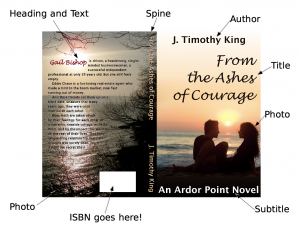
As an indie author, you probably need to understand book-cover design. Traditionally published authors have their publishers’ experts to design their covers (whether or not those experts are worthy of the designation). Self-published authors, just printing up a few copies for family and friends, will probably be satisfied with the très kewl cover design tools at Lulu. But us indie authors need something more than a bare-bones, stock cover. And we don’t have the budget for a professional designer. And even if we do, we don’t have a publishing company helping us choose the designer. So we need to understand book-cover design, if not to design a decent cover ourselves, at least to know what to work on with our designer.
So what makes a good cover?
The cover is the first thing a prospective reader will see of your book. This is true whether she’s looking online or whether someone hands her a copy, or even if she happens to see a copy in a bookstore.
When someone picks up a new book for the first time, watch them. Here’s what they do:
- The examine the front cover.
- If they like what they see, they turn the book over and read the back-cover copy.
- If they still like what they see, they flip the book open to the first page.
This is the order in which you should design your book cover. The front cover must pique her interest and make her want to find out more about the book. And that’s all it should do. The only function of the front cover is to make the prospective reader want to read the back cover. The only function of the back cover is to make her want to crack open the book. And the function of the first page inside the front cover is to set her on a “slippery slide” (to use Joe Sugarman’s terminology) that will end with her buying and reading your book.
The front cover should contain prominent elements—like the title and cover image—that catch the eye and pique the interest. The back cover leverages those elements with descriptive text, to excite and hook the potential reader. The inside-front cover and first page contain additional sales elements, such as bulleted features or testimonials, to close the sale if the cover failed to do so.
Book-cover elements
To make this sequence work, you have a number of elements you can use:
-
Title – This is probably the most important element of your book (unless you’re Nora Roberts or Stephen King—more on that later), especially if it’s a non-fiction book. The purpose of the title is to make your reader look at the subtitle, and the purpose of the subtitle is to make her turn the book over and read the back cover.
For From the Ashes of Courage, I began with a list of words that related to the theme of the story. Then I combined them in various ways: adjective + noun, noun + preposition + noun, and so forth. I chose my three favorites. Then I actually tested the prospective titles and subtitles in Internet ads, to see which one provoked the most interest.
-
Subtitle – All non-fiction books should have a subtitle, and most fiction books as well. The subtitle expands on the title and helps incite your reader to turn the book over and read the back cover. Your book’s title and subtitle must make the right prospective reader want to know more, and you should probably ad-test them to verify that they accomplish that purpose.
The subtitle of the Ashes of Courage book is “An Ardor Point Novel.” I actually ad-tested this with the title, knowing that I hoped to reuse it over a series of books.
-
Photos or drawings – A photo adds visual richness and an emotional dimension to a cover. This is especially true for novels, but no less so for non-fiction books. The purpose of the photo is to get your reader’s attention, hook her with an emotional subtext, and lead her to the title and subtitle. Glancing at the cover photo, you should be able to tell whether the novel is a romance, a thriller, a fantasy, a murder mystery, a space opera, or whatever. For a non-fiction book, a well-chosen front-cover graphic should support the main theme of the book and serve as an icon for its content.
In the Ashes of Courage book cover, I used a stock photo for the front cover. You can license high-quality, royalty-free, stock photos from several sites, for less money than you’ll spend on your first box of books, and such a photo adds a pro flair to your cover design. For the back cover, I found a shot that a photography enthusiast had taken of Merepoint, Maine (the real-life location that inspired Ardor Point). I licensed this photo from her, manipulating it slightly to fit in with the rest of the cover design.
-
Color scheme and fonts – Some graphic designers swear by their favorite colors and fonts, and swear against other colors and fonts. I don’t know that it’s quite that big of a deal, but you should definitely be aware of your color and font choices. The color scheme and fonts on your cover should first of all be legible, and second of all, they should support the feeling you want to evoke. A fantasy-romance, for example, would probably use a different font than a business textbook, but there are any number of fonts that each of these might use.
The font and colors of From the Ashes of Courage, I chose them thinking “a romantic sunset on the beach,” which is also the theme of photo, coincidentally (or maybe not so coincidentally).
-
Author – If you’re Stephen King or Nora Roberts (or Kathy Reichs—as in the book cover example below), your publisher will put your name top and center on your front cover, in huge letters. That’s because your name is what’s selling the book. On popular novels, the author’s name is usually more important even than the title of the book. Maybe everyone knows that Stephen King has a new book out, but maybe they don’t all remember what it’s called. I’m not convinced that this rule holds for indie authors (or even for mid-list authors). And I’m certain it doesn’t hold for non-fiction books. While you might still want to put your name on the front cover, you probably want to keep it subservient to the title and subtitle.
As you can see, I kept my name at the top of the cover, but off to the edge and in a smaller font than the title. I reasoned that it would probably be important someday to my die-hard fans, but that the title and photo were the central elements that should dominate the cover.
-
Front-cover text – You may have opportunity to include snippets of text on the front cover, to reinforce the front cover’s mission. If you do have such an opportunity, take it. This is why books often have words like “New York Times best-selling author!” in a smaller font on the front cover, because the author’s name is selling the book, and any little bit of “Ooh! Aah!” you can add to reinforce that strategy, you Ooh! it and you Aah! it.
You can see that I put no supplemental text on the front cover above, not even a glowing quote from an unknown nobody. Change of strategy: publicize the next book at least to fellow indie authors, and ask for a marketing one-liner.
-
Back-cover heading and text – The back cover should tell the reader something about what’s in the book— unless you’re selling the book solely on popularity, in which case you should fill the back cover with testimonials. For most of us, the back cover should begin with a heading that leads into a block of text. This text is an advertisement for your book. I don’t have the space in this short (and quickly growing longer) blog post to talk about what makes a good ad. However, I can say this: the back cover is not a description of the book; it’s not a book report for your fifth-grade school teacher; rather, it’s a teaser, something that must make a prospective reader want to read the book.
I started with my single-sentence description of the novel, which was designed to highlight the “I gotta read this!” points of the story, and I expanded on it. Since the book is a romance, I said something about the characters, and their problems, and the hook, and a hint that there might be an unexpected twist in their story.
-
ISBN – In your cover design, remember to leave room for the ISBN bar code, at the bottom edge of the back cover. Most books put it in the middle, but it is acceptable to put the bar code off to one side or the other. And while the bar code can be on a field of any light color, the more contrast (white and black), the better.
In my process, this bar code is added later, after the cover is designed. But I still had to allocate a 1.75″ x 1″ space for it, which I marked with a white-filled rectangular.
-
Spine – The spine is what a prospective reader will see first if he doesn’t see your front cover first. So the spine has the most important elements from the front cover, usually the title and author name. Sometimes, publishers will also include a selling point, like “#1 Best-selling Author!” on the spine, because in a bookstore, most books are spine-out. A prospective reader will browse book spines on the shelves, looking for one to pull out and look at more closely. So in that context, the purpose of the spine is to make the reader want to look at the front cover.
-
First-page text – The first page, just inside the front cover, even before the title page: oft-overlooked prime real-estate. Here you can include bullet points describing features the reader will find in the book, or reviewer testimonials, or even an author bio (if you think it’ll help sell the book). You can even include reviewer comments regarding an earlier book in the series, or another book written by the same author. Anything that didn’t fit on the back cover can go here.
For Ashes of Courage, I didn’t forget about the first page. Rather, I ran out of material, a definite lack of marketing foresight. (For my previous book, I filled this space with bullet points and reader testimonials.) As I said, for the next Ardor Point book, I’ll have to get more feedback from fellow authors and ask for testimonials.
Death du Jour, by Kathy Reichs
Another example, this time by a pop author, that demonstrates the principles above.
-
The two most important elements are the author’s name and the title, in that order. These two elements dominate both the front cover and the spine.
-
There’s no front-cover image to speak of—there’s no room after the author’s name and the title. But in the background is a map of Montreal and the surrounding area, where the story takes place.
-
The large, capitalized, serif font and the black-and-red-and-white color scheme enhance the feel of a mystery thriller (which this novel is).
-
Front-cover and spine text: “New York Times Bestselling Author…” and “#1 International Bestselling Author,” as well as a quote from People magazine and an announcement of an upcoming TV series based on the novels. Even the publisher’s logo on the spine. All these help reinforce the impression that this is a well-read and well-liked popular book. And if everyone else is reading it… Well, my personal gut reaction is that if everyone else is reading it, that probably means it falls into Sturgeon’s 90% that constitutes “crud.” And my momma always told me, if everyone else jumped off a cliff, does that mean I should, too? But that’s one of my unusual quirks. Most people go with the more instinctive reaction: if everybody’s reading it, then I have to, too.
-
Similarly, on the back cover, more praise for Kathy Reichs, along with a one-sentence hook about the novel’s story, followed by the title. That kicks off a more elaborate teaser. I myself would have omitted the title from the back cover, and put the sentence at the top in boldface… or at least I would insist on split-tests that proved that the way they did it was better.
-
The back cover also has a quote from USA Today. And the raves continue inside the front cover, with more quotes about Death du Jour, some reviewer raves for another of Kathy Reichs’s novels, and a smattering of cover images for other books, along with short quotes about those books. All of this supports the impression that Kathy Reichs is a prolific, well-published, and popular author. Everyone is reading her books, and her books keep getting published and keep selling. Therefore, if everyone is reading her books, I gotta read them, too!
-
One side note: On the back cover, just above the ISBN barcode, the publisher has included a note: “Register online at www.simonsays.com for more information on this and other great books.” I would be interested to know how many people actually see this note and respond to it. It’s in completely the wrong place, and it’s not specific enough. The note should be on the book’s title page or on the last page, after the story, in a location a satisfied reader is more likely to see it. And if you pull up that URL in your web browser, you simply see the publisher’s web site. Nothing about “registering,” at least not prominently displayed there. It’s a good idea to use your physical book as a calling card to connect with readers online, and a strategy I include in every one of my books. But I’m not convinced that cover real-estate is best used for that function.
Talyn, by Holly Lisle
And one more example, one of my favorite novels of all time (which is why it’s so well-worn), by mid-list author Holly Lisle.
-
Title: “Talyn.” Author: “Holly Lisle.” Subtitle: “A Novel of the [sic] Korre.” (Oy vey. Korre is a place, not a thing.) Holly is a mid-list author, so her (rabid) fans (among which I proudly count myself) will notice her name. But most new readers will be swayed by the graphics, title, teaser, and testimonials.
-
Graphic elements: A semi-nude Talyn, with her warrior’s braids and tattoos, standing before an altar of candles; the wall of a primitive structure in the background; a sword; red and brown and yellow colors; a sword-like stylized font. Could it be a fantasy about a beautiful female warrior from an exotic culture? Yeah, it just might. All of these front-cover images have special meaning to fans of the book, as well, since they’re prominent elements in the story universe.
-
Front-cover text: a testimonial by a “New York Times bestselling author.” Because we all know that New York Times bestselling authors have more valuable opinions on books than, say, you or I. But again, it triggers a human instinct, that if a well-liked celebrity author loves this book, even if I’ve never heard of her or her work, then it’s gotta be worth reading. Note also that including the name “Jacqueline Carey” and the title of her bestselling novel “Kushiel’s Dart,” these pieces of information add credibility to the testimonial, even if you’ve never heard of Jacqueline before or her novel.
-
Back cover: Highlighted header leading into a teaser. And another testimonial. (All this should be old hat to you by now.) Leading into the first page inside the front cover, which displays more testimonials, including— Hold on! Haven’t I seen that quote from Robin Hobb somewhere before?
-
The only thing they could have done better, perhaps, is to include a brief author bio in the empty space on the first page: “author of over 30 novels, two-time Campbell Award finalist,” and so forth.
I haven’t gone into any of the nuts and bolts, what software to use and how to create any of the effects you see here. That is so another post (or two or three or ten). But hopefully, if you’re serious about indie-publishing your books, this will give you an idea of how to approach the design of the cover.
Keep writing!
-TimK
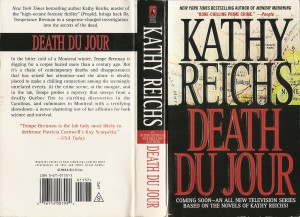
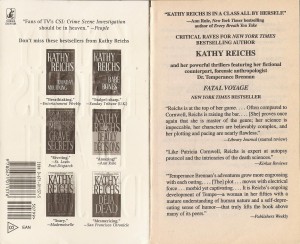
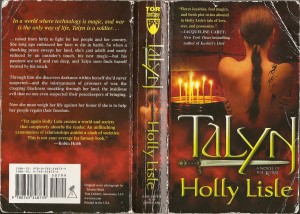
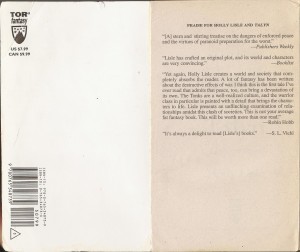
Leave a Reply